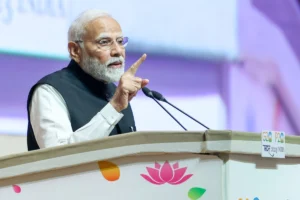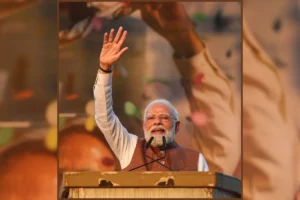
Expressing displeasure with the Bhartiya Janta Party, Nitish Kumar once stated, Mar jaana qabool hai lekin unke (BJP) saath jaana humko kabhi qabool nahin hai (I’d rather die than tie up with them)”. The question is, What are the compulsions that compelled Nitish Kumar to join the NDA Block and leave the RJD and INDIA bloc Alliance?
Changes in alliances may create difficulty in seat-sharing
With the return of Nitish Kumar to the NDA, the equation has changed in the NDA and INDIA coalition in Bihar. The NDA alliance now includes the following parties – BJP, JDU, LJP, Jitan Ram Manjhi’s party HAM and Upendra Kushwaha’s party. At the same time, only RJD, Congress and Left parties are remaining in the opposition INDIA coalition.
In this way, the coalition situation in Bihar is seen on the lines of the 2019 Lok Sabha elections. Still, one difference is that Kushwaha and Manjhi were with the Mahagathbandhan in the last election, but are now with the NDA. The BJP-led NDA will contest this time with a tough clan.
Bihar has 40 Lok Sabha seats. In the NDA, the seat was to be shared among the BJP, LJP, HAM and Kushwaha’s party, but now after Nitish becomes a part, JDU will also be playing a significant role. In the 2019 Lok Sabha elections, BJP-JDU-LJP contested together, in which BJP contested 17, JDU 17 and LJP 6 seats.
JDU contested an equal number of seats. Before Nitish came to the NDA, the BJP was planning to contest at least 30 seats in Bihar, but in Lok Sabha Election in 2024, the formula of equal seats can be formed between the two parties again. Apart from this, Manjhi, Kushwaha, Chirag’s LJP and Pashupati Paras’s party will also have to take seats of their shares.
Before Nitish left the opposition coalition, a seat-sharing formula was being formulated, in which there was a plan to fight an equal number of seats between RJD and JDU. In this way, it was being agreed to contest 17-17 seats and the Congress was expected to get four to five seats and the Left was being given only two seats. After the separation of JDU, Congress and the Left are likely to get more seats in the opposition alliance. In Bihar, the Left is demanding four to five seats, while the Congress is demanding 8 to 10 seats. In such a situation, RJD may not give seats to its allies Congress and Left as per their demand, but they can get more seats than before.
Why does the BJP need Nitish Kumar?
While Nitish Kumar was in the opposition alliance, the battle in Bihar seemed very difficult for the BJP because a similar situation had occurred in the 2015 assembly elections, in which the Grand Alliance was overshadowed. The reason behind this is the caste equation of Bihar and the voting pattern based on caste. It was being said in media reports that BJP’s internal survey in Bihar was not getting good feedback about the Lok Sabha elections. In Bihar, the INDIA alliance of JDU-RJD and Congress was looking strong, but after Nitish changed sides, the political picture changed. The BJP seems to be benefiting the most by bringing Nitish Kumar into its fold because JDU is the third force in Bihar.
As mentioned above, the survey revealed that the BJP was not getting anticipated feedback about Lok Sabha Elections, BJP played its gambette. Prime Minister Narendra Modi wants a bigger victory in this election than the previous term and the equation of Bihar and Maharashtra could have become an obstacle in fulfilling his goal. In fact, compared to other states of North India, Bihar is the only state where BJP is not as strong, on top of this, the combination of JDU and Mahagathbandhan had increased BJP’s tension.
Everyone knows how important caste politics is in Bihar. 30 percent of the state’s population belongs to EBC i.e. ‘Extremely Backward Class’. These EBC castes include Kurmi, Nishad, Koyri, Nai, Teli and people of these castes mostly vote for Nitish Kumar’s party. The Bharatiya Janata Party wants to cultivate this vote bank in every situation in the Lok Sabha elections.
NDA’s performance in the 2019 Lok Sabha elections with Nitish Kumar in his fold. NDA had 39 seats out of a total of 40 seats and a vote share of 54.3% and UPA grabbed only 1 seat with a 32.6% vote share. BJP wants to repeat the 2019 verdict. According to Some Opinion Poll, what if NDA had entered the field without Nitish in the 2024 Lok Sabha elections? NDA would get 16-18 seats only with a vote share of 39% and Indi Alliance may get 21-23 seats with a 43% vote share.
What is the calculation of 51 percent votes?
Chief Minister Nitish Kumar belongs to the Kurmi caste, while Deputy Chief Minister Samrat Chaudhary belongs to the Koeri caste. Both these castes come under the Most Backward Class (EBC) in Bihar. Which has the highest population of 36 percent. The other deputy chief minister, Vijay Kumar Sinha, belongs to the Bhumihar caste, which is an upper caste and constitutes 15 per cent of Bihar’s upper caste population. In this way, in the 2024 Lok Sabha elections, the NDA has made a strong gathering of 36 + 15 i.e. 51 percent votes in Bihar.
Why is Nitish Kumar important for Bihar?
Nitish Kumar created the image of Good Governance Babu among the Jungle Raj of Bihar. He succeeded in changing the image of Bihar to some extent as it was infamous for crime, ransom and defamation of the state. At one time during his regime, the growth rate of Bihar was the highest in the entire country. He succeeded in maintaining an honest image compared to his opponents. Affidavits show that even today Nitish does not have much in the name of property.
Why did Nitish reverse?
It is being told that there was pressure to make Tejashwi Yadav the CM and Lalu Prasad’s interference was increasing. The experiment of the INDIA alliance appeared to be failing and differences were emerging among the allied parties. There was an atmosphere of distrust within JDU. INDI alliance parties did not pay attention.
Also Read: Jharkhand CM Hemant Soren ‘Missing’? Everything You Need To Know About His Disappearance
To read more such news, download Bharat Express news apps




















